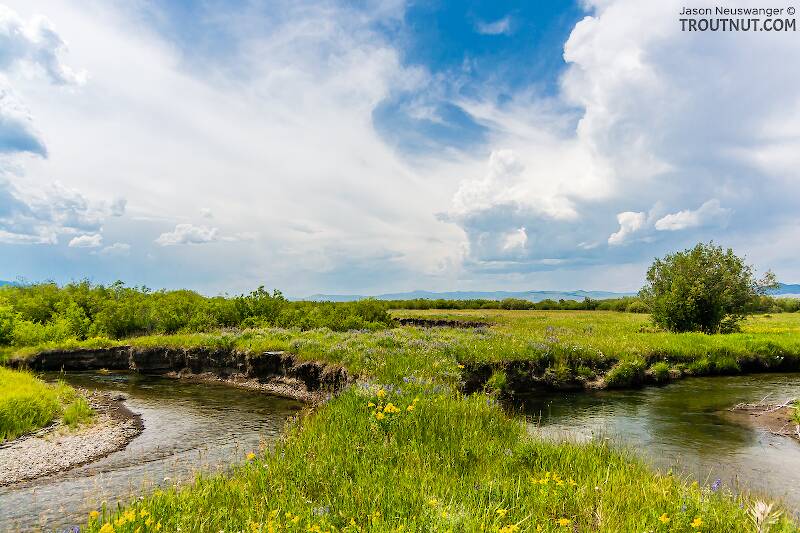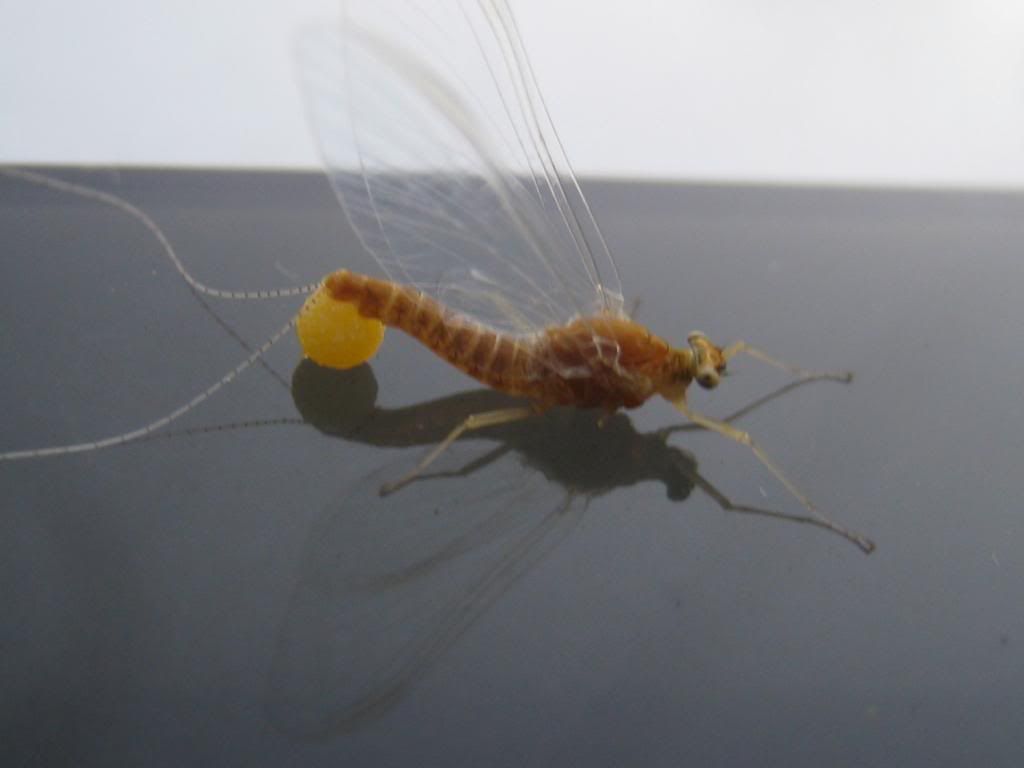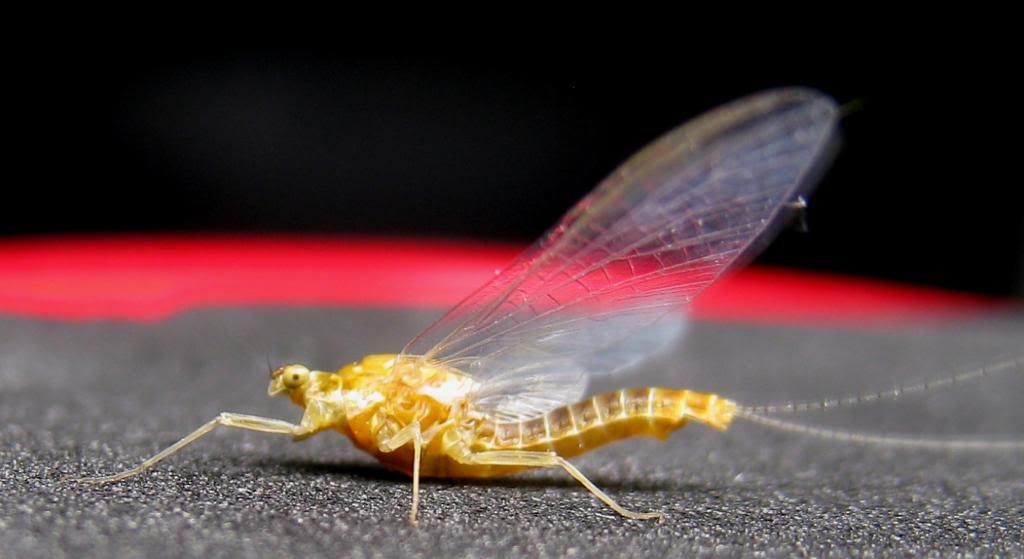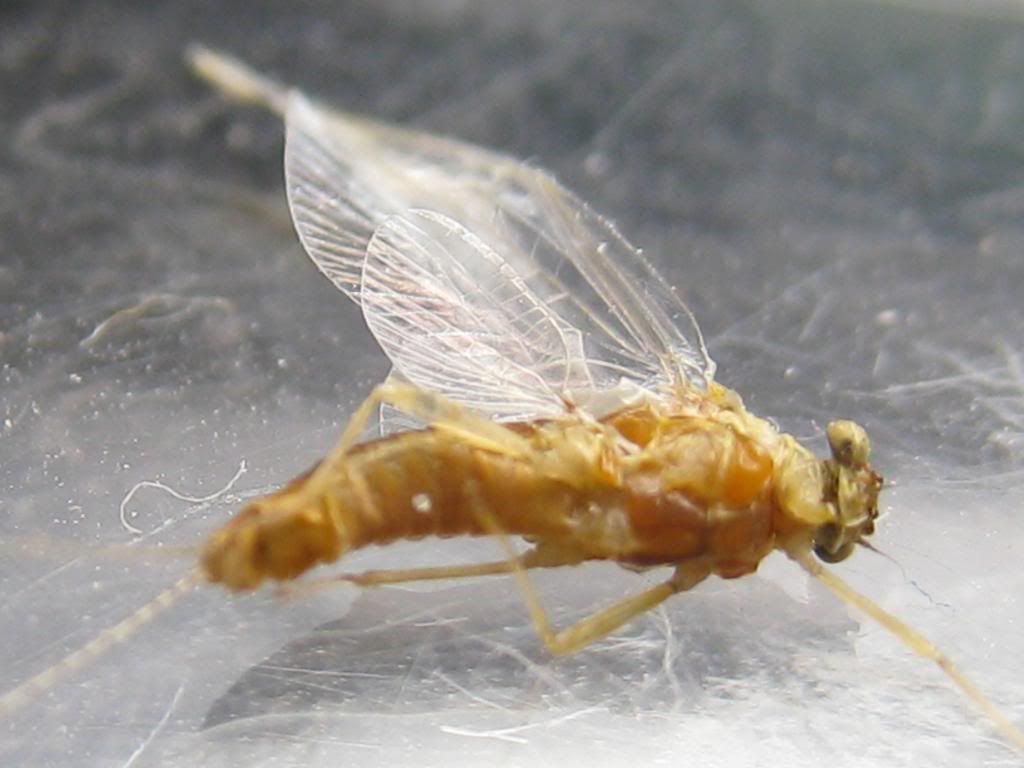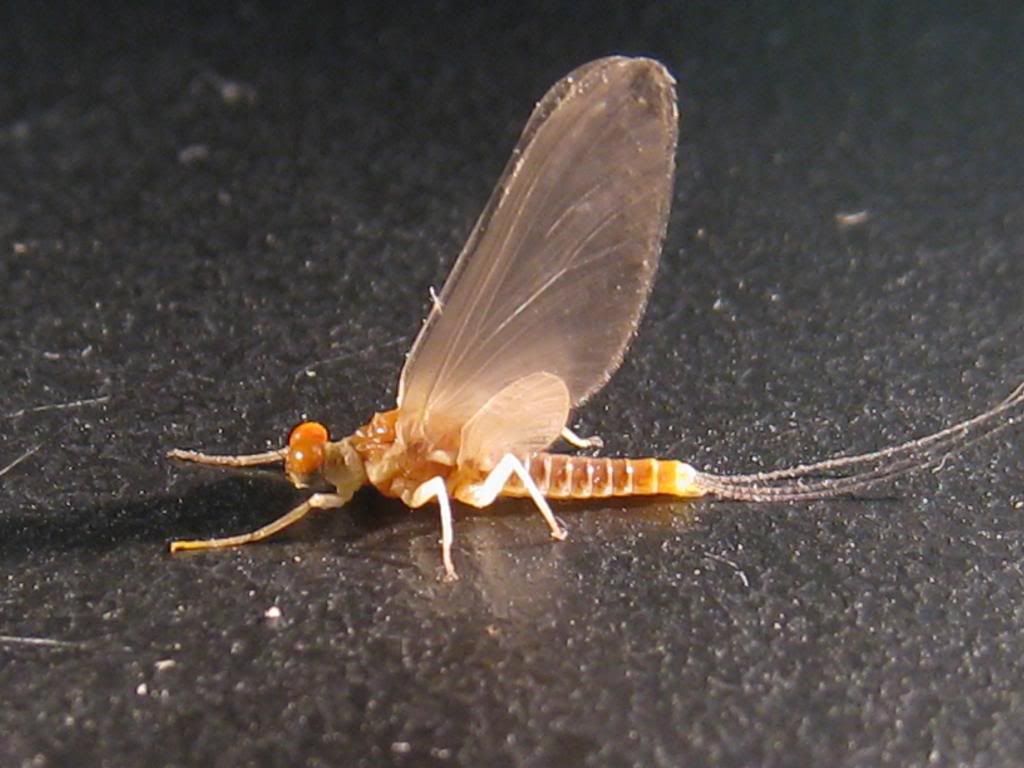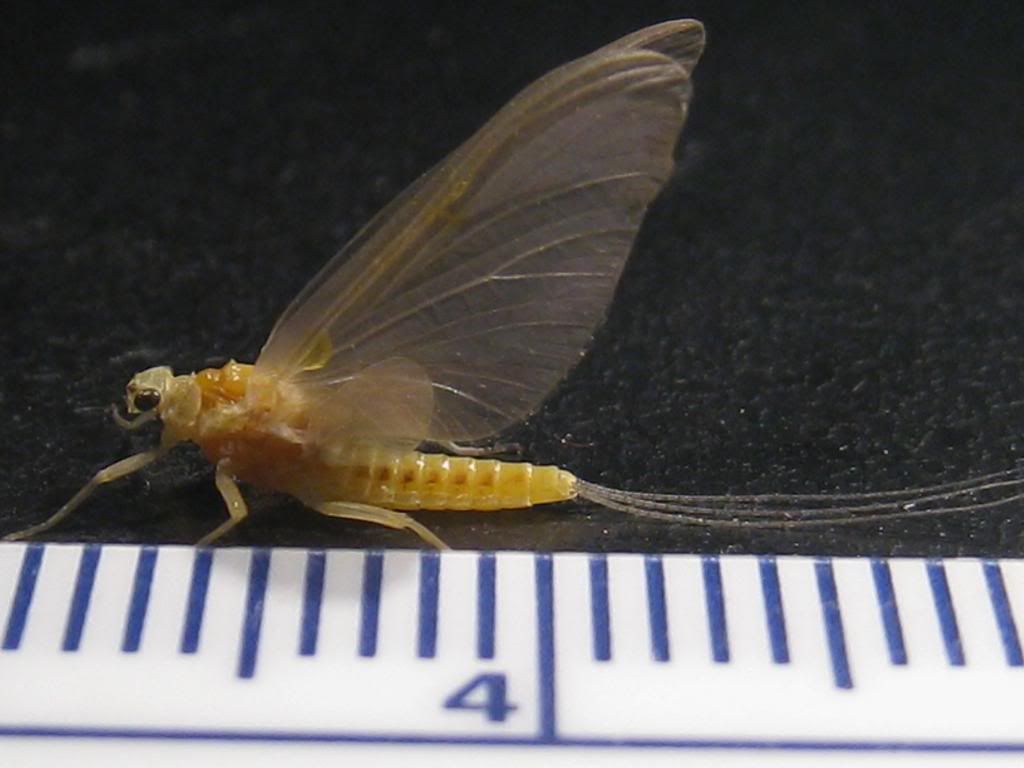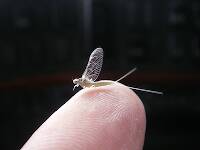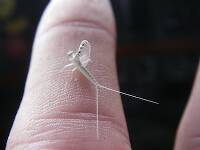
Hex Mayflies
Hexagenia limbata
The famous nocturnal Hex hatch of the Midwest (and a few other lucky locations) stirs to the surface mythically large brown trout that only touch streamers for the rest of the year.
Featured on the forum

This one seems to lead to Couplet 35 of the Key to Genera of Perlodidae Nymphs and the genus Isoperla, but I'm skeptical that's correct based on the general look. I need to get it under the microscope to review several choices in the key, and it'll probably end up a different Perlodidae.

Troutnut is a project started in 2003 by salmonid ecologist Jason "Troutnut" Neuswanger to help anglers and
fly tyers unabashedly embrace the entomological side of the sport. Learn more about Troutnut or
support the project for an enhanced experience here.
Oldredbarn on Oct 21, 2013October 21st, 2013, 2:24 pm EDT
No comments yet from Roger or Kurt?! There must be something weird going on over on the Letort, because these bugs look like they should be around in May and not October! Especially the second pic...Looks like it was lifted right from Hatches under E invaria or some such...
That Cumberland Valley is warmer than the rest of the state, but this would be ridiculous!
Eric...You said Ephemerellid after my quess the other day...So what is it? :)
Spence the Befuddled (no wise cracks from the peanut gallery...Bruce!)
That Cumberland Valley is warmer than the rest of the state, but this would be ridiculous!
Eric...You said Ephemerellid after my quess the other day...So what is it? :)
Spence the Befuddled (no wise cracks from the peanut gallery...Bruce!)
"Even when my best efforts fail it's a satisfying challenge, and that, after all, is the essence of fly fishing." -Chauncy Lively
"Envy not the man who lives beside the river, but the man the river flows through." Joseph T Heywood
"Envy not the man who lives beside the river, but the man the river flows through." Joseph T Heywood
Crepuscular on Oct 21, 2013October 21st, 2013, 2:50 pm EDT
Eric...You said Ephemerellid after my quess the other day...So what is it? :)
My best guess would be E. invaria. I did not see a male on Friday evening when I collected this one. There weren't many but there were more than I could count. I don't recall seeing them before in October but that doesn't really mean anything. Usually I'll start seeing them in January. (but then I'm looking for them.) I wouldn't be surprised if they are present in small numbers virtually all year long.
Oldredbarn on Oct 21, 2013October 21st, 2013, 3:01 pm EDT
Wow! Could there be something about that slow monster of a stream that would/could lend itself, along with the moderate temps, for a multi-brooded E invaria? We might have to alert/wake up the boys from Purdue...Luke you out there somewhere? :)
Eric...Since you were kind enough to grant my request by posting this...A nod to an old drinking buddy...Will we get a snipit of your encounter on that storied stream with one of its ledgends? Marinaro and Mr Fox both considered him the guy when it came to catching the Big Boys of the Letort...That was before you came along of course. ;)
Spence the Supplier of the Molsons. :)
Eric...Since you were kind enough to grant my request by posting this...A nod to an old drinking buddy...Will we get a snipit of your encounter on that storied stream with one of its ledgends? Marinaro and Mr Fox both considered him the guy when it came to catching the Big Boys of the Letort...That was before you came along of course. ;)
Spence the Supplier of the Molsons. :)
"Even when my best efforts fail it's a satisfying challenge, and that, after all, is the essence of fly fishing." -Chauncy Lively
"Envy not the man who lives beside the river, but the man the river flows through." Joseph T Heywood
"Envy not the man who lives beside the river, but the man the river flows through." Joseph T Heywood
Martinlf on Oct 21, 2013October 21st, 2013, 4:54 pm EDT
Yikes! Who knows what's going on over there with the invarias! Eric's observations certainly have my brain swimming in regard to what he's seen. I'll bet there's something publishable happening if he has the time and inclination. Or perhaps it should stay more on the QT.
"He spread them a yard and a half. 'And every one that got away is this big.'"
--Fred Chappell
--Fred Chappell
Oldredbarn on Oct 21, 2013October 21st, 2013, 6:17 pm EDT
Louis,
Grab your May sulpher box and meet me in Carlisle! ;) I'll be the guy in the over-loaded vest standing by the plaques for Fox and Marinaro...
Spence
Grab your May sulpher box and meet me in Carlisle! ;) I'll be the guy in the over-loaded vest standing by the plaques for Fox and Marinaro...
Spence
"Even when my best efforts fail it's a satisfying challenge, and that, after all, is the essence of fly fishing." -Chauncy Lively
"Envy not the man who lives beside the river, but the man the river flows through." Joseph T Heywood
"Envy not the man who lives beside the river, but the man the river flows through." Joseph T Heywood
Taxon on Oct 21, 2013October 21st, 2013, 7:31 pm EDT
Hi Spence-
I would lean toward Ephemerella excrucians.
No comments yet from Roger or Kurt?!
I would lean toward Ephemerella excrucians.
Entoman on Oct 21, 2013October 21st, 2013, 8:03 pm EDT
Could be, Roger. Seems on the small side for invaria. Jeez, Eric! I'm still amazed at your Winter sulfurs. Now your pulling Fall ones out of your waters?:)
"It's not that I find fishing so important, it's just that I find all other endeavors of Man equally unimportant... And not nearly as much fun!" Robert Traver, Anatomy of a Fisherman
Crepuscular on Oct 22, 2013October 22nd, 2013, 5:08 am EDT
I would lean toward Ephemerella excrucians.
Interesting. Why? Hoover in his Biodiversity of Ephemeroptera of PA (2000) only found 3 larvae and that was from the western part of the state. I would love to hear why you are leaning toward E. excrucians. I just asssumed it was E. invaria. Allen and Edmunds 1965 only have lengths for males and if we are ok with saying that the females are generally the same size or larger than the males this specimen would fit in E. excrucians and E. invaria.
Taxon on Oct 22, 2013October 22nd, 2013, 6:14 am EDT
Hi Eric-
Everything else being pretty much equal, I leaned toward E. excrucians based on the emergence date. I have the end of emergence for E. invaria listed as mid-June, and E. excrucians as mid-September.
I would love to hear why you are leaning toward E. excrucians.
Everything else being pretty much equal, I leaned toward E. excrucians based on the emergence date. I have the end of emergence for E. invaria listed as mid-June, and E. excrucians as mid-September.
Crepuscular on Oct 22, 2013October 22nd, 2013, 6:40 am EDT
Oldredbarn on Oct 22, 2013October 22nd, 2013, 7:56 am EDT
OK...Charlie & Vinny must of been up to some very odd experiments over there on their "crick"! They are laughing at us from their graves. :)
You and your son aren't raising these critters in the basement are you? Ala Brookyman...Hmmm...
Spence
You and your son aren't raising these critters in the basement are you? Ala Brookyman...Hmmm...
Spence
"Even when my best efforts fail it's a satisfying challenge, and that, after all, is the essence of fly fishing." -Chauncy Lively
"Envy not the man who lives beside the river, but the man the river flows through." Joseph T Heywood
"Envy not the man who lives beside the river, but the man the river flows through." Joseph T Heywood
Entoman on Oct 22, 2013October 22nd, 2013, 9:02 am EDT
Notice the mesonotal conical projections on the Winter specimens? The Fall one lacks this character. Also, the dorsal maculation is quite different. The fact that they are different stages could account for the latter, though.
Aren't they a bit large for Attenella? My gut tells me they are both probably different species of Ephemerella. A good look at the male nasties (even a dun's) and an associated nymph will sort this out. On Attenella, the clasper's terminal seg will be very long (6 x width). On Ephemerella, they are very short (less than 1.5 times). After that, it gets a little trickier to tell with photos. Penes, fore tarsi and feet are hard to get in focus.:)
Aren't they a bit large for Attenella? My gut tells me they are both probably different species of Ephemerella. A good look at the male nasties (even a dun's) and an associated nymph will sort this out. On Attenella, the clasper's terminal seg will be very long (6 x width). On Ephemerella, they are very short (less than 1.5 times). After that, it gets a little trickier to tell with photos. Penes, fore tarsi and feet are hard to get in focus.:)
"It's not that I find fishing so important, it's just that I find all other endeavors of Man equally unimportant... And not nearly as much fun!" Robert Traver, Anatomy of a Fisherman
Crepuscular on Oct 22, 2013October 22nd, 2013, 10:42 am EDT
Well I guess the plot has thickened somewhat. In this speciemn of E. invaria http://www.troutnut.com/specimen/734 those dorsal mesonotal conical projections seem to be visible. And they are also visible in the photo of the Attenella specimen that Roger posted. But are absent in other specimens of E. invaria here. So what does that mean? Does that character stay with the imago? I would tend to think so. I also tend to think, like you said Kurt, that these are possibly two different species but I'm not sure about that. Another character that I noticed when comparing the two is the acute angle of the costal projection on the hindwing of the specimen collected last Friday. Maybe it's just the angle of the photograph. Any thoughts on that? I guess I need to get out and do some collecting.
Entoman on Oct 22, 2013October 22nd, 2013, 11:00 am EDT
Yeah, that's why those projections aren't used in ephemerellid keys. Assuming they're both Ephemerella, a bit of luck is that the penes of the two species mentioned are quite different. You have that male specimen handy? Even in the dun stage the differences should be readily apparent.
As for the hind wing, I agree that's another un-keyed difference that points to a difference. Perhaps you found something cryptic?
As for the hind wing, I agree that's another un-keyed difference that points to a difference. Perhaps you found something cryptic?
"It's not that I find fishing so important, it's just that I find all other endeavors of Man equally unimportant... And not nearly as much fun!" Robert Traver, Anatomy of a Fisherman
Quick Reply
Related Discussions
Topic
Replies
Last Reply
10
May 24, 2009
by Wiflyfisher
by Wiflyfisher
0
May 3, 2007
by Troutnut
by Troutnut
5
Dec 18, 2013
by Brookyman
by Brookyman
10
Jul 27, 2008
by Phillyfired
by Phillyfired
0
Jul 10, 2006
by Troutnut
by Troutnut

